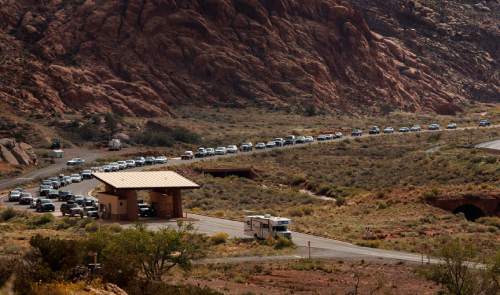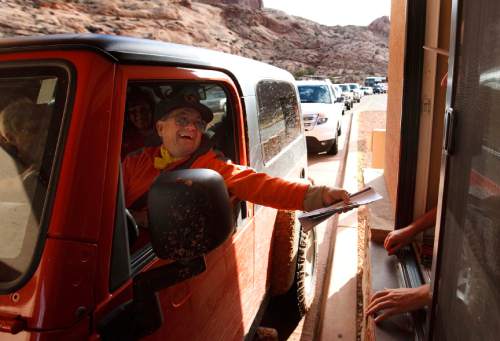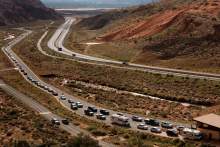This is an archived article that was published on sltrib.com in 2016, and information in the article may be outdated. It is provided only for personal research purposes and may not be reprinted.
The freshly expanded parking area serving Arches National Park's Devils Garden is designed for 185 cars, but over Memorial Day weekend, 340 drivers managed to "creatively" park their vehicles there at one time.
More cars were parked for a mile along both sides of the approach road that takes visitors to Landscape Arch and other geological wonders that make the Utah preserve near Moab internationally famous.
Utah Highway Patrol troopers had to shut down the park entrance for two hours because lines of cars were posing a safety hazard on U.S. 191.
Park Superintendent Kate Cannon likes to see people flocking to Arches, but says such congestion should not be part of the park experience.
"It's a mixed blessing," Cannon said. "We want people to come to the parks and enjoy these marvelous places. But we want them to do it in ways that keep the qualities of the park intact."
This week, the National Park Service began soliciting public comment on various ideas under consideration to address a growing traffic crisis at Arches and Canyonlands national parks.
Proposals for Arches include "timed-entry" tickets, shuttle buses, more parking lots, new entrance roads, parking fees and time limits, parking attendants and site-specific permits to encourage visitation at less busy areas, including Courthouse Wash and Panorama Point.
The proposal that could generate the most controversy may be a requirement for "timed entry" tickets that would function like a reservation system. The park service uses such a system for overnight visits to popular backcountry destinations, including the White Rim Trail, but this would be the first for entering a park.
"The advantage to visitors," Cannon said, "is they could sign up well ahead of time and be certain they can get in the park and won't have to wait in line and have a reasonable expectation they can tool around the park and find parking without much difficulty."
Traffic gridlock has been a problem as visitation continues to grow at many marquee national parks, including Yosemite, Yellowstone and the Grand Canyon. But some Utah parks are experiencing a steep increase in the number of cars on park roads, including Zion.
Last year was a record year for Arches, with 464,138 vehicles entering the park — up 17 percent from the previous year. And this year, visitation appears to be up 20 percent.
"The National Park Service does not promote the parks, but other people do," Cannon said. "We think the skill with which the state has carried out the 'Mighty 5' campaign has to be a factor.
"It's not just Memorial Day," she added. "For the past couple years, the lots have been so full, visitors park along the roads and walk to the attractions."
Such conditions are now the norm at Arches' three main hiking destinations: Devils Garden, Windows and Delicate Arch, Utah's signature landmark that appears on countless marketing materials.
In 2013, the state Office of Tourism launched its trademark marketing campaign, drawing attention to Utah's five national parks.
Many in Moab now are wondering if Mighty 5 has been too successful, complaining that the town is "drowning" in tourism. Residents can't find places to live. Employers can't hire people fast enough. Dumpsters are overflowing. Rented off-road vehicles are motoring in the streets. The sewer system is overtaxed. And several new hotels have been proposed.
But not everyone is complaining.
"For me, it's not a problem. Mighty 5 has done exactly what it's supposed to do. It addresses five parks; Arches is not alone," said Marian DeLay, executive director for the Moab Travel Council. "We use the word 'challenge.' A real problem would be if less people come to the park, which is what canceling the marketing campaign could do."
Still, others worry the parks' traffic "challenge" could damage the Moab brand and wind up pushing away visitors.
Canyonlands National Park's Island in the Sky, located 30 miles south of Arches, also is clogged. Cars were backed up two miles at the entrance during Memorial Day weekend.
At Arches, daily vehicle counts topped 2,800 during Memorial Day weekend, the park's busiest of the year. That's more than double the daily average for 2014.
A shuttle service may seem like an obvious solution, but park managers studied a nonmandatory system three years ago and concluded its $3 million cost outweighed its benefits.
"There is a role for shuttles, but not as a stand-alone solution," Cannon said. "It is a cumbersome, complicated solution, and we are not sure it's needed. Agile private-sector shuttles are an intriguing idea. We have 30 operators that can bring people into the park on vans, SUVs and buses."
Zion National Park operates a mandatory shuttle system through the narrow 8-mile canyon during peak season. It has been praised for solving traffic gridlock, but, in recent years, visitors have complained about packed buses and excessive crowding on popular trails accessed from shuttle stops.
Arches and Canyonlands will raise their entrance fees from $10 to $25 on Oct. 1, but Cannon expects to offer a $10 discount for visitors entering at off-peak hours and times of year.
"The discounted times would be revised to reflect changes in visitation patterns," Cannon said. "The park isn't crowded all the time. We have to push that high visitation in the middle of the day to earlier and later times."
A reservation to visit Arches?
The National Park Service is soliciting public comment through Aug. 19 on a "traffic congestion management plan" for Arches and Canyonlands national parks. Park managers will conduct an environmental assessment during the coming year and release a final plan near the end of summer 2016. Submit comments by e-mail to seug_planning@nps.gov or by mail to the National Park Service, Attn: Planning and Compliance, 2282 SW. Resource Blvd, Moab, UT 84532. › XX







